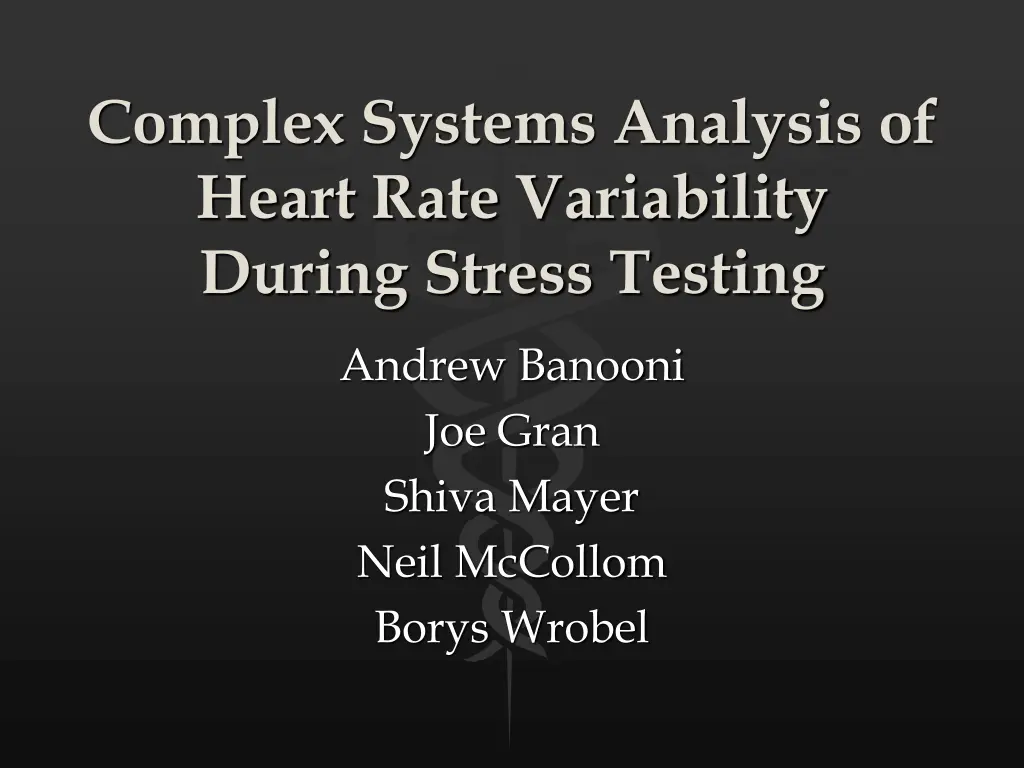
Heart Rate Variability Analysis in Stress Testing Research
Explore the complexities of heart rate variability during stress testing, the significance of reduced HRV as a mortality predictor, ECG analysis, stress test HR data, Poincaré plots, and detrended fluctuation analysis in cardiovascular health research.
Download Presentation

Please find below an Image/Link to download the presentation.
The content on the website is provided AS IS for your information and personal use only. It may not be sold, licensed, or shared on other websites without obtaining consent from the author. If you encounter any issues during the download, it is possible that the publisher has removed the file from their server.
You are allowed to download the files provided on this website for personal or commercial use, subject to the condition that they are used lawfully. All files are the property of their respective owners.
The content on the website is provided AS IS for your information and personal use only. It may not be sold, licensed, or shared on other websites without obtaining consent from the author.
E N D
Presentation Transcript
Complex Systems Analysis of Heart Rate Variability During Stress Testing Andrew Banooni Joe Gran Shiva Mayer Neil McCollom Borys Wrobel
Why HRV? Reduced HRV as a predictor of mortality Electrocardiogram (ECG) n t nt heart 1 + heart HRV (SD) (msec) time (sec) Heart Rate = heart n +1 heart n RR t t n Kleiger RE, Miller JP, Bigger JT, Moss AJ, Decreased heart rate variability and its association with increased mortality after acute myocardial infarction. Am J Cardiol. 1987;59:256-262 time (msec)
The Electrocardiogram (ECG) Einthoven s Triangle http://physchem.ox.ac.uk/~wayne/ECG%20etc/ Field%2012%20Lead%20ECG%20Diagnosis_files/ triangle.gif http://upload.wikimedia.org/wikipedia/com mons/0/0b/ECG_Principle_fast.gif http://upload.wikimedia.org/wikipedia/commons/b/bd/12leadECG.jpg
Stress Tests HR t I II III IV
Our Data 12 leads 400 300 200 +noise 100 0 -100 -200 6.395 6.4 6.405 6.41 6.415 6.42 5 x 10 300 250 200 True RR Series 150 100 50 0 -50 -100 7000 7200 7400 7600 7800 8000 8200 8400 8600 8800 9000
Poincar Plot Plot of RRt vs. RRt+1 Additional time- scales possible (t+2, t+3, etc ) Studies have shown SD1/SD2 ratio decreases at lag levels of 4 heartbeats in hemodialysis patients
Poincar Plot SD1 vs SD2 SD2 0.2 0.15 0.1 0.05 0 0 0.01 0.02 0.03 0.04 0.05 0.06 0.07 0.08 0.09 0.1 SD1
Detrended Fluctuation Analysis Loss of fractal scaling in: Elderly individuals Heart disease Dilated cardiomyopathy Sleep apnea Prediction of arrhythmias Additional prognostic information not present in time or frequency domains Developed specifically to distinguish between intrinsic (local) and extrinsic (long- range) fluctuations Scale invariant, and not affected by non- linearities or fractal properties
Detrended Fluctuation Analysis Peng, CK et al. (1995). Quantification of scaling exponents and crossover phenomena in nonstationary heartbeat time series. Chaos 5(1):82.
Detrended Fluctuation Analysis 2 Alpha 1 vs Alpha 2 1.6 1.4 1.2 1 0.8 0.6 0.4 0.2 0 0.4 0.6 0.8 1 1.2 1.4 1.6 1.8 2 1 Peng, CK et al. (1995). Quantification of scaling exponents and crossover phenomena in nonstationary heartbeat time series. Chaos 5(1):82.
Our Hypothesis: Robustness (the ability to compensate for a physiologic stress) can be inferred from the dynamics of a free-running physiologic system in the basal state. Experimental Methods: Using a set of approximately 300 cardiac exercise stress tests Predict the response to the stress (specifically rate of heart rate increase and loss of heart rate variability) from the initial (basal, free-running) segment. Predict the rate of recovery (rate of heart rate decrease, recovery of variability) when the stress is removed Classify the results of the stress test as "normal" or "abnormal" based solely on analysis of the dynamic complexity, using the official interpretation as the gold standard
Future Directions exponential fit ~exp(-t/Toff)
Future Directions Additional metrics for the basal state: Poincar methods (2D and 3D) Lyapunov exponents Correlation dimension Kolmogorov entropy Correlate basal with phases II and III Determine normal and abnormal based on complexity measures
